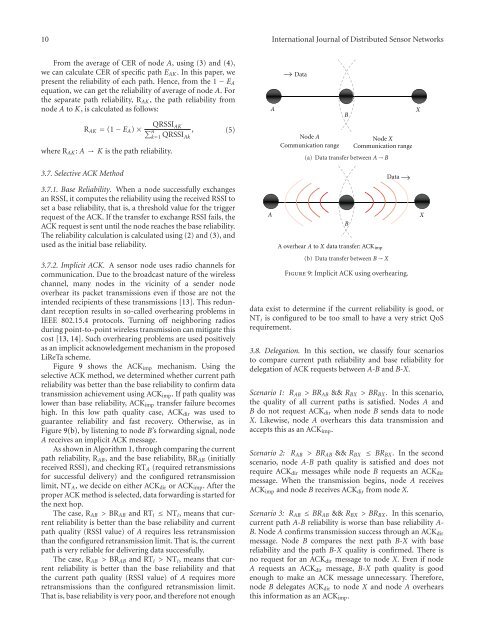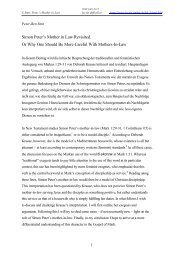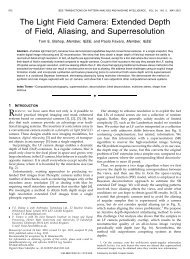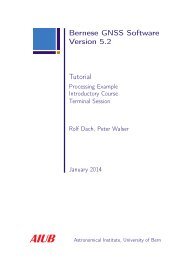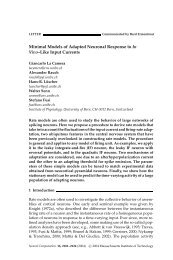Deploying Real-Life WSN Applications: Challenges ... - IAM - CDS
Deploying Real-Life WSN Applications: Challenges ... - IAM - CDS
Deploying Real-Life WSN Applications: Challenges ... - IAM - CDS
Create successful ePaper yourself
Turn your PDF publications into a flip-book with our unique Google optimized e-Paper software.
10 International Journal of Distributed Sensor Networks<br />
From the average of CER of node A, using (3) and(4),<br />
we can calculate CER of specific path E AK .Inthispaper,we<br />
present the reliability of each path. Hence, from the 1 − E A<br />
equation, we can get the reliability of average of node A.For<br />
the separate path reliability, R AK , the path reliability from<br />
node A to K, is calculated as follows:<br />
A<br />
Data<br />
B<br />
X<br />
R AK = (1 − E A ) ×<br />
where R AK : A → K is the path reliability.<br />
QRSSI AK<br />
∑ nk=1<br />
QRSSI Ak<br />
, (5)<br />
Node A<br />
Node X<br />
Communication range Communication range<br />
(a) Data transfer between A → B<br />
3.7. Selective ACK Method<br />
3.7.1. Base Reliability. When a node successfully exchanges<br />
an RSSI, it computes the reliability using the received RSSI to<br />
set a base reliability, that is, a threshold value for the trigger<br />
request of the ACK. If the transfer to exchange RSSI fails, the<br />
ACK request is sent until the node reaches the base reliability.<br />
The reliability calculation is calculated using (2)and(3), and<br />
used as the initial base reliability.<br />
3.7.2. Implicit ACK. A sensor node uses radio channels for<br />
communication. Due to the broadcast nature of the wireless<br />
channel, many nodes in the vicinity of a sender node<br />
overhear its packet transmissions even if those are not the<br />
intended recipients of these transmissions [13]. This redundant<br />
reception results in so-called overhearing problems in<br />
IEEE 802.15.4 protocols. Turning off neighboring radios<br />
during point-to-point wireless transmission can mitigate this<br />
cost [13, 14]. Such overhearing problems are used positively<br />
as an implicit acknowledgement mechanism in the proposed<br />
LiReTa scheme.<br />
Figure 9 shows the ACK imp mechanism. Using the<br />
selective ACK method, we determined whether current path<br />
reliability was better than the base reliability to confirm data<br />
transmission achievement using ACK imp . If path quality was<br />
lower than base reliability, ACK imp transfer failure becomes<br />
high. In this low path quality case, ACK dir was used to<br />
guarantee reliability and fast recovery. Otherwise, as in<br />
Figure 9(b), by listening to node B’s forwarding signal, node<br />
A receives an implicit ACK message.<br />
As shown in Algorithm 1, through comparing the current<br />
path reliability, R AB , and the base reliability, BR AB (initially<br />
received RSSI), and checking RT A (required retransmissions<br />
for successful delivery) and the configured retransmission<br />
limit, NT A , we decide on either ACK dir or ACK imp . After the<br />
proper ACK method is selected, data forwarding is started for<br />
the next hop.<br />
The case, R AB > BR AB and RT i ≤ NT i , means that current<br />
reliability is better than the base reliability and current<br />
path quality (RSSI value) of A requires less retransmission<br />
than the configured retransmission limit. That is, the current<br />
path is very reliable for delivering data successfully.<br />
The case, R AB > BR AB and RT i > NT i , means that current<br />
reliability is better than the base reliability and that<br />
the current path quality (RSSI value) of A requires more<br />
retransmissions than the configured retransmission limit.<br />
That is, base reliability is very poor, and therefore not enough<br />
A<br />
A overhear A to X data transfer: ACK imp<br />
B<br />
(b) Data transfer between B → X<br />
Data<br />
Figure 9: Implicit ACK using overhearing.<br />
data exist to determine if the current reliability is good, or<br />
NT i is configured to be too small to have a very strict QoS<br />
requirement.<br />
3.8. Delegation. In this section, we classify four scenarios<br />
to compare current path reliability and base reliability for<br />
delegation of ACK requests between A-B and B-X.<br />
Scenario 1: R AB > BR AB && R BX > BR BX . In this scenario,<br />
the quality of all current paths is satisfied. Nodes A and<br />
B do not request ACK dir when node B sends data to node<br />
X. Likewise, node A overhears this data transmission and<br />
accepts this as an ACK imp .<br />
Scenario 2: R AB > BR AB && R BX ≤ BR BX . In the second<br />
scenario, node A-B path quality is satisfied and does not<br />
require ACK dir messages while node B requests an ACK dir<br />
message. When the transmission begins, node A receives<br />
ACK imp and node B receives ACK dir from node X.<br />
Scenario 3: R AB ≤ BR AB && R BX > BR BX . In this scenario,<br />
current path A-B reliability is worse than base reliability A-<br />
B.NodeA confirms transmission success through an ACK dir<br />
message. Node B compares the next path B-X with base<br />
reliability and the path B-X quality is confirmed. There is<br />
no request for an ACK dir message to node X. Evenifnode<br />
A requests an ACK dir message, B-X path quality is good<br />
enough to make an ACK message unnecessary. Therefore,<br />
node B delegates ACK dir to node X and node A overhears<br />
this information as an ACK imp .<br />
X


